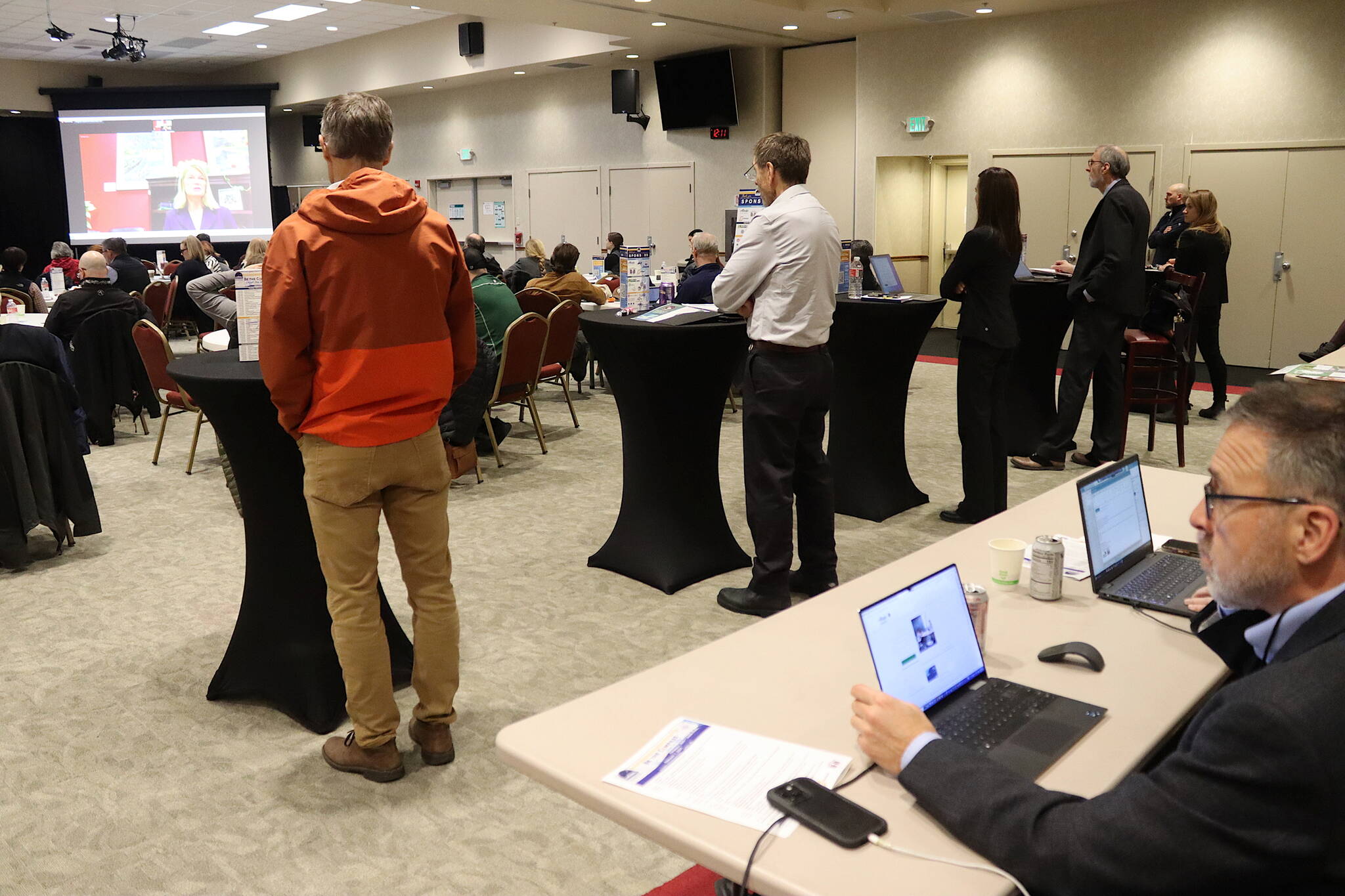The grim news is Juneau’s youth population is in a significant and long-term decline. The good news is one study declares the city has the second-best summer job market for youths in the United States.
A wide range of similar bad news/good news points were shared by regional business, political and other leaders during the two-day Southeast Conference Mid-Session Summit at Elizabeth Peratrovich Hall on Tuesday and Wednesday. Officials discussing the bleak present status of the state’s ferry system also talked about a vibrant future, with others noting setbacks in the seafood industry occurring during a surging of the mariculture industry.
A reference point throughout the summit was an update of the annual report “Southeast Alaska by the Numbers,” presented within the first hour of the gathering by Meilani Schijvens, owner of Rain Coast Data.
“We’re going to have five updates: three of them are going to be great, two of them are not going to be so great,” she said in setting the tone for the conference.
Schijvens said one of her favorite updated findings is a WalletHub study assessing the best places in the U.S. to get summer jobs, with Juneau ranking third overall and second for youths ages 16-24.
“Having kids in that age group, and having their friends be also in that age group, I can tell you the hype is real,” she said. “It is just really a great time to be young in Southeast Alaska. There’s so many job opportunities, the jobs pay well, they’re good jobs that provide career pathways into year-round employment.”
A key reason for that is also a key concern throughout Alaska — there are roughly two job openings for every person seeking a job, Schijvens said. Furthermore, Southeast Alaska’s population is dropping more than anywhere else in the state with a 2.22% decline between 2021 and 2023, followed by the northern region at 2.2%, Southwest Alaska at 2.01% and Interior at 1.58%. The Anchorage/Mat-Su and Gulf Coast regions both reported increases of 1% or more.
In Southeast, the biggest losses were in Skagway at 7%, Haines at 4%, and Ketchikan, Yakutat, Wrangell and Hoonah-Angoon at 3%. Juneau’s population declined 2% during that three-year period.
Schijvens said some of the factors include Southeast’s population being older on average than the rest of the state — with deaths outnumbering births for the first time ever — an increase in outmigration of the prime-age working population starting in 2021,
“We need to really figure out how to get younger people to come to Southeast Alaska, we need to figure out how to attract and retain younger families,” she said. “And we know how to do this. We’ve done the surveys, we’ve done the analysis. What younger people need, they need access to housing that they can afford, they need access to childcare they can afford, they need access to transportation that they can afford. I think we need to make sure that we’re keeping up that high quality of recreation, so continuing to invest in places like Eaglecrest. We need to make sure the quality of life is really high here, so we need to continue to lean into those activities for kids and quality in K-12 education.”
Another of the “great” updates in the report is jobs grew 2% in 2023 compared to 2022, indicating a full recovery from the COVID-19 pandemic when compared to employment for February in 2019, Schijvens said. But the rate of growth is slowing, as a 13% decline in employment in 2020 was followed by a 5% increase in 2021 and 3.4% increase in 2022 — and there is a projected increase of 1.4% in 2024.
“Transportation is where we have the largest job growth, followed by construction, tourism, healthcare, local government, professional business and financial services, and retail,” she said.
Tribal government, the fastest-growing jobs sector in 2022, saw a loss of eight total jobs in 2023, suggesting difficulties filling open positions rather than a downturn, Schijvens said. A similar loss of eight jobs was reported for federal government jobs.
“Our loss leader continues to be state government,” she said. A total of 120 jobs were lost in 2023 and “in the last 12 years we’ve lost a quarter of all state jobs in Southeast Alaska — that represents 1,400 jobs.”
Looking ahead to 2024, however, Schijvens said the concern is the seafood industry, the only sector where a loss of jobs is forecast in her updated report. Employment in the industry remained flat in 2023 at roughly 3,650 total jobs — following a loss of nearly 270 jobs between 2021 and 2022 — another that is expected to decline by another 100 employees in 2024.
Among the reasons for the industry’s decline, she said, are a global downturn in seafood demand, a glut of inventory and crash of salmon prices, and Trident Seafoods announcing in December plans to divest itself of facilities in Ketchikan and Petersburg.
Growth in tourism and healthcare jobs are forecast in 2024, while mining, construction and transportation are expected to remain flat, according to Schijvens
Another plus, Schijvens said, is wages have risen about 5% while inflation has stabilized at rates that have been less than 2% annually since last June.
However, housing availability and prices continue to present challenges, she said. The average price of a single-family home nationwide is about $343,000 nationwide and $360,000 in Anchorage this year, but about $494,000 in Juneau — the highest among all Southeast Alaska cities in her report.
• Contact Mark Sabbatini at mark.sabbatini@juneauempire.com or (907) 957-2306.

